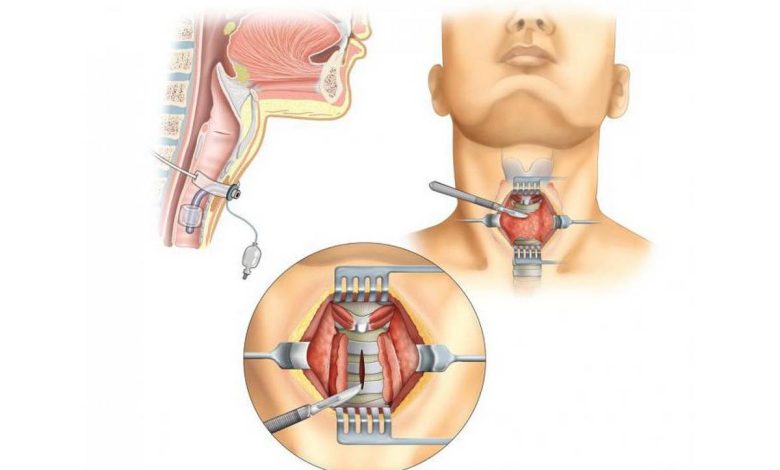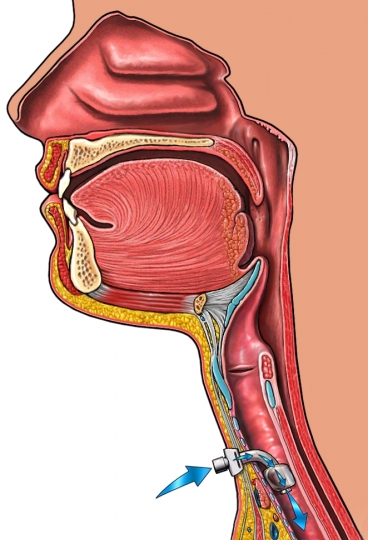Tracheotomy, tracheostomy: what is the procedure, causes, Contraindications, how they do it, what after

Description tracheotomy
Tracheotomy – operation to make holes in the skin on the outside of the neck into the trachea. To ensure normal breathing tube is inserted into the hole. Tracheotomy is performed to bypass obstructions, that interfere with breathing. The hole is called a stoma or tracheostomy. The stoma can be temporary or permanent.
In an emergency situation it can be made krikotireotomiya. This type of operation should be used only temporarily. If the hole will be necessary to breathe more 48 hours, It will make the standard tracheotomy.

The reasons for performing a tracheotomy
Tracheotomy is used to open the airways. The procedure is done to restore normal breathing in the following situations::
- The airways are blocked at or above the level of the larynx as a result of:
- Injuries to the neck;
- Tumors of the upper respiratory tract;
- Respiratory insufficiency, require long-term mechanical breathing support, for example in the following cases:
- Spinal cord injury in the neck;
- Severe infection or inflammation of the lungs;
- Damage to the respiratory tract due to smoke inhalation, steam or inhaling corrosive substances;
- Birth defects of the trachea or larynx;
- Foreign bodies, blocking the trachea or larynx;
- Severe sleep apnea.
Possible complications of tracheotomy
If you plan a tracheotomy, you need to know about possible complications, which may include:
- Bleeding;
- Infection;
- Damage to the vocal cords, Voice nerves, going to the brain, esophagus;
- Damage to the lungs;
- Difficulty swallowing;
- Low blood pressure;
- Dislodging or damaging the tube in the stoma;
- Scars on-site operation, leading to the closure of the tracheostomy.
Some factors, that may increase the risk of complications:
- Age: children and the elderly;
- Obesity;
- Smoking;
- Poor diet;
- Recent illness, particularly upper respiratory tract infection;
- Alcoholism;
- Prolonged illness;
- The use of some drugs.
How is the tracheotomy?
Preparation for the procedure
Before tracheotomy doctor may be appointed or conducted following:
- Chest X-ray – test, which uses X-rays to take pictures of structures inside the body;
- Blood and urine tests;
- Revision of the medication;
Tell your doctor about taking any medications. A week before surgery, perhaps, you need to stop taking certain drugs:
- Aspirin and other nonsteroidal anti-inflammatory drugs (eg, Ibuprofen, naproxen);
- Blood-thinning drugs, such as warfarin;
- Antiplatelet drugs, such as clopidogrel.
Anesthesia
When applied tracheotomy general anesthesia, which supports a patient in the sleep state during operation. In an emergency, local anesthesia.
Procedure tracheotomy
The skin of the neck incision is made. Then the section is removed in the trachea. In the prepared hole in the trachea will be set tracheostomy tube, which will replace the airways. The skin will be closed around the tube sutures or staples.
While the pipe is mounted in the throat, You will breathe through it. To help with mechanical ventilation, can be used respirator.
You can not say, until you close the hole in the tracheostomy tube, because the air enters and exits the tube bypassing the vocal chords.
Immediately after tracheotomy
Maybe you need chest X-ray.
How long will the tracheotomy?
About 15-30 minutes.
Tracheotomy – Will it hurt?
Anesthesia prevents pain during the procedure. Pain and discomfort can be felt during recovery. The doctor will give pain medicine for pain relief.
The average time of stay in the hospital after tracheotomy
Length of stay will depend on the cause treatments. Usually the duration of stay of 1-5 days.
Care after tracheotomy
- Keep the stoma clean. Clean it daily with mild soap and water or with hydrogen peroxide. Change the bandage clean and dry;
- Ask the doctor, when it is safe to shower, bath or expose the surgical site to water;
- Find Out, how to take care of the tracheostomy tube:
- Clean the tube;
- Regularly purge tube to remove secretions;
- It should be a regular humidification;
- Cover the hole scarf before going out, to dust, dirt and other foreign particles are not able to enter the tube;
- Be very careful, breathing in water or inhaling fine particles (such as food, Powders, Aerosols, dust) through the tracheostomy;
- Close the tracheostomy hole with your fingers, to speak;
- Consult a speech therapist, if recommended by your doctor;
- Take antibiotics, if prescribed by your doctor;
- It is recommended to return to daily activities to promote healing;
- Avoid intensive exercise for six weeks after surgery;
- Be sure to follow your doctor's instructions.
After installing the tracheostomy tube you will experience changes in breathing and speech. Getting used to the change typically takes three days. Initially, you may be hard to talk.
Contact your doctor after tracheotomy
After discharge from the hospital need to see a doctor, if there was any of the following symptoms of:
- Signs of infection, including cough, excessive secretion of fetid mucus, fever and chills;
- Redness, edema, strong pain, bleeding or discharge from the incision;
- Nausea and / or vomiting, that do not pass after taking the prescribed medicines and persist for more than two days after discharge from the hospital;
- Pain, which does not pass after taking pain medication appointed;
- Cough, shortness of breath or chest pain.
If the tracheostomy tube falls, and you can not put it into place, immediately seek medical advice.
